Achievements/Outcome of Directorate
Major Achievement
- An Australian patent (No. 2020102879) was granted for the technique ofdiagnostic assay of Porcine Circovirus 2 infection in
- Theinnovation on multi-column sand filter has been patented (Patent 345919).
- One Cassava variety TCa13-1 (CAU-Umangra 1) and three varieties of rice,CAU-R2 (Tomthinphou), CAU-R3 (Mangalphou) & CAU-R4 (Eenot Phou ) were released and published in the gazette of India vide notification No. CG-DL-E-09012020-215253.
- A transboundary disease surveillance laboratory in North East of India has been established for the diagnosis and monitoring of potential transboundary diseases of bacterial, viral and fungal origins in livestock, poultry and wild animals with origin from neighboring North Eastern
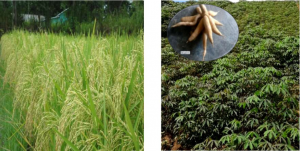
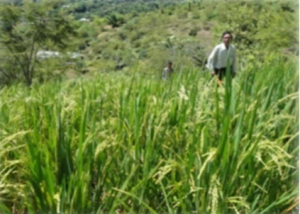
Figure 3: Field view of CAU-R2 (Tomchin Phou), CAU-R3 (Mangal Phou) and Cassava Tcal3-1(CAU-Umgra 1) - Anovel isothermal polymerase spiral reaction (PSR) is developed for detection of eaeA gene in coli isolated from diarrhoeic pig, cattle, sheep and goat.The technique is useful to diagnose the disease at field level without any sophisticated equipment.
- First time in India, the seed production under captivity has been developed and standardized for Clarias magur, a delicacy fish of North East of India.
- A low-cost pond based thermo-securable hatchery for multi-species fisheshas been developed which has shown high farmer receptivity. This solar electricity-based system has a capacity to produce 1 m spawn per cycle.
 Figure 2: Pond based thermo securable hatchery
Figure 2: Pond based thermo securable hatchery
- Ahigh throughput rohu fingerling production based on live wolffia has been developed which has shown high farmer acceptability because of the cost and ease of maintenance, Wolffia an exclusive nutrient input/feed is found to be suitable for rohu fingerling
- Established Bio pesticide production unit eat CPGSAS, CAU (I), Umiam, Meghalaya.
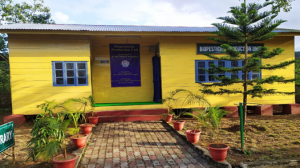 |
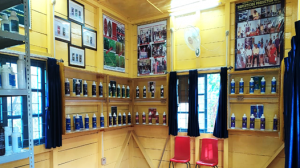 |
- Developed ten (10) bioformulation technologies of fungal antagonists (viz., UmTricho, UmTriv, UmLec), fungal entomopathogens (UmBir, Umcill, UmMet), bacterial antagonists (UmRaj, Bapseudo) and liquid microbial consortia (UmTim, UmComb).
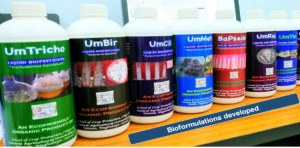 Display of bioformulations developed through native biocontrol agents
Display of bioformulations developed through native biocontrol agents
- Quality planting material production on Tuber Crops during 2020-2021
| Sl. No. | Name of the Crop | Name of the variety | Quantity of planting material produced | Area covered (ha) |
| 1. | Cassava | Sree Jaya Sree Vijaya Sree Prakash CAU Umangra-1 | 1000 –stems 1000 –stems 1000 –stems 3000 –stems | 0.2 |
| 2. | Sweet Potato | NFSP-1 Sree Bhadra ST-14 | 1500 vine cuttings 1500 vine cuttings 1500 vine cuttings | 0.05 |
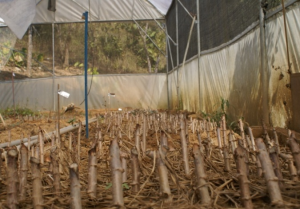 | 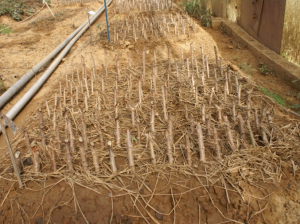 |
- Evaluated newly developed chickpea desi varieties under irrigated timely sown condition during rabi season 2020-21.
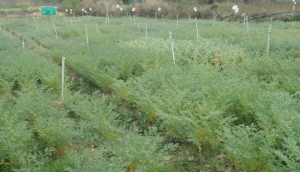 Fig 1. Overview field of Experiment
Fig 1. Overview field of Experiment
- Survey were conducted in different districts of Manipur. 5 apiaries in 5 districts were surveyed and were examined for the incidence of diseases and enemies. During surveyed no mites were found and some wax moth were also found. Beekeepers have reported mortality of bees due to use of pesticides. The diets were given to the colonies during January 2021 and data were recorded after three days and seven days. The maximum consumption of CAU pollen substitute was noticed in TIRI (9.3) gm followed by T1R5 (7.8) gm. The pollen consumed in remaining treatments in the range of (0.6 -3.9) gm. The maximum exit from hives in morning was higher than in the afternoon and least in the evening. The maximum exit activity was recorded by colonies with CAU pollen substitute with a mean no. of 35.4 followed by PAU pollen feed colonies with a mean no. of 15.2 and minimum by colonies with Solan pollen substitute feeding with 8.2.
- Started mass multiplication of laboratory host, Corcyra cephalonica along with two egg parasitoids, Trichogramma japonicum and T. chilonis. Parasitised Tricho cards were produced.
- Temperature and rainfall data of Sikkim, Meghalaya, Mizoram and Jammu & Kashmir is anlysed. Drought intesntites were calculated for these states. Primary data were collected on effect of climate change on spice crops and growers’ livelihood in Meghalaya and Mizoram.
- Morphological, Molecular and Biochemically identified the Fusarium udum associated with pigeon pea wilt disease.
- Field evaluation of Trichoderma against Alternaria and Fusarium spp of potato diseases showed reduction on disease incidence on Trichoderma (31.25%) besides mancozeb(23.25%)in comparison to control(46.25%)plot.
- Field evaluation of bioagents against early blight of tomato showed best by mancozeb(15.50%), followed by Trichodrma (35.00%) as compared to control (75.00%).
- Evaluation of liquid formulation of Trichoderma against Fusarium wilt of tomato showed reduction on disease incidence (4.12%) as compared to control(11.13%).
- A total of 31 new crosses were attempted at the Centre using different parents for Toria, Indian Mustard and Yellow sarson. The F1generated will be evaluated in the next season.
| Crop | No. of Crosses | Parent material used |
| Indian Mustard | 21 | Local yella (new collection), PM 25, NRCHB 101, JD 6, DRMR-150-35, Kranti, Pusa Bold |
| Yellow Sarson | 10 | YSH 0401, Pitambari, Benoy, NRCYS-05-02, DRMR-643 |
| Total | 31 |
- Set of superior lines for cross LR 23 x LR 26 further characterized and chromosome 2 region (1.84 Mb) identified for better performance under lowland acidic soil conditions.
- Sambha Mahsuri sub1 introgression lines (ILs) fixed for qDTY1and qDTY3.1 obtained by crossing Sambha mahsuri sub1 introgression lines carrying qDTY1.1 and DRR 50 (SAB X DRR). Three families carrying recombination between qDTY1.1 and SD1, thereby, leading to semi-dwarf plants were obtained
- Evaluated for inheritance of Turcicumblight resistance in 105 F4 and 145 F5 lines which had been forwarded using SSD.
- Off season generation advancement of the mapping population from F5to F6 has been completed.
- Generation advancement of the mapping population from F6to F7 generation has been done during the main season at research plots in CPGS-AS (Umiam), ICAR (Umiam) and CAU (Imphal).
- Hydroponic study for the performance of the RILs for aluminium tolerance and phosphorus acquisition efficiency is being set up.
- IPM package and practices in rice and vegetable crops were validated and promoted in hill/tribal regions of Meghalaya under three major districts , Ri Bhoi, East Khasi Hills and West Khasi Hills Districted of Meghalaya.
- Performance of bio formulation were evaluated for pest and disease management in rice, fall army worm of maize, leaf spot of turmeric, tikka disease of groundnut, early blight of tomato, white mold of French bean and pest-free cultivation of ornamental plants, pea, strawberry, cabbage. Field trials were conducted in three (3) states of North-Eastern India , Meghalaya, Arunachal Pradesh and Assam.
- Conducted OFT on root-dipping in SSP-MC slurry method of P-Management in transplanted rice growing areas during Kharif,2020 at Duski ADC village, Khowai, Tripura.
- Estimated the production and utilization pattern of milk and milk products during flush season in India.
- Two entries nominated for AICRP IVT-M(H) trials. Two entries promoted to AVT-M(H) trials- CAUS 107 (IET 28210) and CAUS 124 (IET 28970).
- Seven AICRP trials conducted- AVT-I-II-Early (775), AVT-I-II-Medium (776), NIVT Early (785), OPV (787), Sweet corn (792), Popcorn (793), Baby corn (791). The 110 fixed lines which had been crossed to L-13 and L-14 tester lines (made available from PAU, Ludhiana) in a Line X Tester mating design are presently being evaluated in the second sowing window. One season of evaluation data of the same planted in August 2020 is already available.
- Varietal evaluation of Gladiolous collected from IIHR, Bangalore were evaluated under Sikkim condition.
- Developed and released a Mobile Application for the Subject Mater Specialists to cater the farmer’s voice call with their relevant information on Livestock.
Farmers Registered= 2898
Advisory Provided= 5193
SMS (Text & Voice) created= Text-193, Voice132, Advisory-5208
Awareness camp=9
Animal Health camp=8
Training for farmers=4
Content developed=7
- Standardizedthree anaesthetic protocol with propofol, ketamine and ketofol were found safe and effective in pigs.
- Curing mixture is standardized. Physico-chemical, nutritional and sensory qualities of the products were studied. Vawksa rep could be well preserved upto 20 days in refrigeration temperature .
- Small scales, portable bamboo based silos have been prepared. Maize silage has been prepared using this bamboo based silo. Physico -chemical properties of the maize silage was found to be of good quality.
- Developed multi-residue method for detection of pesticide residues in vegetables and fruit samples collected from markets.
- Studied antidiarrhoeal properties of selected herbs of the North Eastern Region
- Studied the morphology and morphometrical data obtained, that can provide better information to the surgeons during the treatment of head injuries, especially in locating the site for infiltration of the anesthetic drugs for the nerve blocks of maxillofacial and mandibular areas for surgical interventions in both species.
- Evaluated four (04) plant materials from different places of Nagaland and sent to BSI, Shillong for identification and authentication. Having authenticated, methanolic extracts are prepared from the dried plant products. The final plant products were sent to CSIR-CDRI, Luknow for pre-formulation work studying various physicochemical properties of the active pharmaceutical ingredient.
A. conyzoides | Mikania micrantha | L. camara | M. pudica |
- Introduced few new generation practical experiments including demonstration of virulence genes in bacterial pathogens, viral antigens through in situimmunohistochemical assays, antimicrobial sensitivity assays by disk diffusion test, double synergy test, determination of MIC by microdilution method, determination of antimicrobial resistance genes in bacterial isolates, plasmid profiles of pathogenic bacteria, molecular biological techniques for characterization of bacterial, viral and fungal pathogens, preservation of microbial isolates through freeze drying and cryopreservation, biosafety and biosecurity measures in control of microbial diseases in animals including domestic birds, polyacrylamide gel electrophoresis for analysis of proteins and their size determination, gel filtration chromatography for protein purification and separation, ultrasonicator for tissues/ cells disruption, Bioinformatics with introduction to databases (DNA, RNA and protein), nucleic acid / protein similarity searching (BLAST analysis), designing of primers for PCR, cloning etc., patient data entry and its management through veterinary hospital software, micro-chipping of the patients and scanning through a scanner, patient management in a critical care unit, telemetric ECG and Holter monitoring to detect cardiac arrhythmia, collection and analysis of rumen fluid, ophthalmologic and otoscopic examinations in animals, skills in planning, designing of the experiment, to conduct statistical estimation and hypothesis testing with Statistical software, various mating system for animal improvement, estimation of economic losses due to important diseases in livestock population, methodology of selection and breeding systems for genetic improvement of livestock and poultry etc.
- Evaluated of wound healing activities of ethanolic extract of Azl02OPEVM2020V plant.
- Evaluated of Polyherbal formulation of extracts of plants viz. Azl01OPEVM2020U, Azl02OPEVM2020V, Azl03OPEVM2020S and Azl01OPEVM2020B for wound healing activities.
- Initiated selective breeding on Mizo Local (Zovawk) and their up-gradation with exotic inheritance for higher growth and reproductive performances under intensive system of management.
- Analyzed the complete genome sequences of the outbreaks of HP-PRRSV during the period May-June 2020 which were confirmed by reverse transcription PCR, in pig population of Mizoram. The complete genome sequences were analyzed and submitted to GenBank.
- Studied study epidemiology of CPV-2 infection of dogs and cats obtained from NEH states.
- Evaluated the antioxidant potential of glutathione in CPV-2 infected dogs.
- Organized Agripreneurship Orientation Programme (AOP).Twenty five Agripreneurs were trained, mentored and incubated. Five of the incubates/Agripreneurs from this R-ABI centre are selected for pre- stage funding of Rs. 5 lakhs each by the Ministry of Agriculture and Farmers Welfare, Govt of India.
- Under AICRP on Pig project, as many as 218 Rani piglets were produced from continous pig breeding programmes, following AICRP research protocol. FLD programme is also started with distribution of piglets to the selected farmers.
- Under Conservation of Manipuri Pony Project, seven foals were produced during the reporting year, thereby increases the herd strength of this endangered breed.
- Research work on Characterization of Indigenous Manipuri Cattle has been initiated in three valley districts. Maximum part of the research work on Indigenous Haofa Dog, particularly at its original breeding tract at Ukhrul District and other isolated areas has been completed.
- 10(ten)successful foaling (delivery) occurred by using scientific breeding practices, at the Departmental Pony Shed.
- A total number of 233 piglets were produced from the breeding of Rani pigs.
- Formulated and standardized the value added products of pumpkin: Gulab Jamun, Rasgulla , Ice-cream, Pumpkin punch with ginger flavor and pumpkin powder added product mix for sensory analysis.
- Online trainings of Chic™ CAD Plus & DigiBunai™ (CAD applications) were given to weavers, designers and master trainer. A design is made using the software, and saree weaving is processed with silk yarn.
- Shelling machine and ergonomically designed peeling knife were designed and developed to mitigate drudgery of women.
- Taxonomic confirmation of the fish species applying classical and modern tools
- A total of 14230fish specimens under 32 families, 13 order, 95 genera and 228 species were taxonomically identified, cataloged by classical morphological and meristic methods. State wise number of specimens and species permanently identified using classical taxonomy during 2020-21 are as follows:
- Of 228 species identified, 49 species were not identified previously i.e., phase I. Therefore, including both phase I and phase II, a total of 297species at present are permanently identified under the project.
- Few species are found to be cryptic and study is going on to find out if they are new species.
- Population variation of fish species collected from different river systems of NE region in Systomus saranaand Mystus bleekeri was conducted.
- Technology development and intervention for sustainable production enhancement:
- Alternative fish feed, feeding utilizing local resources and grow-out culture technology of prioritized endemic species
- Standardized species composition of IMC as Co-species with pabda as dominant species.
- Standerdized Co-culture of wolffia with magur.
- Bio-floc system found a promising technology for seed rearing of pabda with 62% of survival having FCR of 1.2
- Development of integrated multi-trophic culture system of Labeo rohita, Lamellidens margninalis and Wolffia globossafor improved fish yield, feed utilization and health status of rohu.
- Elucidation of superior performance of polyculture system of Ompok bimaculatus(pabda) as dominant species with Labeo rohita (rohu) followed by that with combination of three Indian major carps namely rohita, Catla catla and Cirrhinus mrigala.
- Evaluation of impact of stocking time on growth and welfare status of belangeriin fed-culture system.
- Establishment and evaluation of system performance in co-culture of fed magur (Clarias magur) with Wolffia globosa.
- Improvement of fish stock and reproductive performance through biotechnological tools
- cDNA synthesiss followed by normal PCR. and RT PCR for the tryptophan experiment tissues sample with reproductive gene specific primer.
- Curcumin (a natural DNMT inhibitor) found to improve colouration through hypomethylation of key involved genes in Zebra fish .
- Improvisation of in-pond low-cost fish seed hatchery
- Improvised in-pond low-cost fish seed hatchery : CAUi-Brshti successfully incorporating solar panel
- Domestication and standardization of seed production of alternative aquaculture food and ornamental fish species
- Produced 2.3 million carp spawn of Pengba ( state fish of Manipur) at college farm and distributed among fish farmers of Tripura.
- Achieved voluntary spawning in captive condition in Clarias magur(Magur) through hormonal manipulation.
- Immunological and microbiological interventions for fish health and environmental management / development and evaluation of aqua-medicines
- Probiotic potential strain P1-Bacillus amyloliquefaciens, P2- licheniformis, P3- B. subtilis, P4- Pseudomonas entomophila P5- P. mosselii , P7- B. paralicheniformis, P8-B. altitudinis, P9- B. subtilis were isolated from the digestive tract of a freshwater teleost rohu (Labeo rohita), and identified using 16S rRNA gene sequence analysis.
- A total of 25 lytic hydrophila phages were isolated which were capable of lysing other Aeromonas species such as A. caviae, A. media, and A. veronii. Characterization results collectively indicate the therapeutic potential of AhP-2 phage against A. hydrophila infection.
- Agro as well as COVID advisory pull based online technical services related to farming practices were provided to 5050 nos registered farmers and also covered 5191 fish ponds of Tripura state.
- Formaldehyde has been detected in Puntius spp., Mystus spp and Macrobrachium fish species above the maximum acceptable limit suggested by FSSAI of which max. was
found in case of Puntius spp. and Mystus spp.
- Livelihood empowerment and development of marketing strategies for fishers
- Continuous proactive calls (5566) and follow-up (3712) call to the farmers were made on regular basis for awareness and sensitization about the project entitled “Matsya Varta” covering all four districts.
- Total 2873 no of advisories were provided by the Experts
- Total 3 expert field visits were done by Agro Associates
- Preparation of different types of content for the farmers is in progress.
- Total 1076565 text, 151921 voice and 17684 transactional messages were pushed to the registered farmers of different districts
- College of Fisheries RKVY-RAFTAAR Agri-Business Incubator (R-ABI)was established during March 2019 under the ‘Rashtriya Krishi Vikas Yojana – Remunerative Approaches for Agriculture and Allied Sector Rejuvenation’ (RKVY-RAFTAAR) scheme of Ministry of Agriculture & Farmers’ Welfare, Government of India.
- In continuation from the previous FY, this year we have conducted 2nd RIC on 12th December 2020 where 5 out of 6 incubates have presented and among them 2 of them got further selection to appear before CIC. On 15th March 2021 CIC was conducted and out of 2 incubates presented before CIC both of them got sanction of Grant-in Aid of Rs. 5 Lakh each.
- Evaluated ten (10) species of orchids and the data has been recorded for various vegetative and flowering parameters. It includes a total of 9 sympodial and 1 monopodial species. Based on their habitat, 9 orchids collected are epiphytic in nature and only one terrestrial orchid i.e. Arundinagraminifoliabeen collected.
- Based on the growth habit and flowering parameters evaluated, the collected orchids can be recommended for use as pot plant, hanging pots and for landscaping as follows:
Pot plant:Coelogyneflavida, Coelogynepuscescens, Luisiatrichorhiza, Eriajavanica,
Eriaflava, Bulbophyllumcauliflorum, Pinaliastricta, Bulbophyllumpteroglossum.
Hanging pots: Pholidotaarticulate, Landscape use: Arundinagraminifolia
Coelogyneflavida Arundinagraminifolia Bulbophyllumpteroglossum
- Punjab Glad can be recommended for commercial cultivation under Pasighat conditions, East Siang District.Punjab Glad performed at par with the check varieties ‘American Beauty’ and ‘White Prosperity’ and was found to be superior in comparison to other varieties evaluated for yield and flowering.
Punjab Glad White Prosperity American Beauty
- Evaluatedthirteen turmeric genotypes from Pasighat Co-opted centre namely CHFT-4, CHFT-8, CHFT-11, CHFT-16, CHFT-24, CHFT-27, CHFT-36, CHFT-40, CHFT-42, CHFT-52, CHFT-72, CHFT-102, CHFT-103 and along with three checks MT-1, NDH-98 and IISR Prathiba in Randomized Block Design with three replications.
- Developed Infrastructure of incubation hub, CHF R-ABI Office, Video Conferencing Hall under the project RashtriyaKrishiVikasYojana – Remunerative Approaches for Agriculture and Allied Sector Rejuvenation (RKVY – RAFTAAR) Agribusiness Incubator. Eight awardees approved and sanctioned Rs. 5 lakhs each as grant-in-aid.
- Identified Protein and Fertilizer Supplements made of Meal Worm Poop; Customizable Veg and non-veg pickles with refill option; digital platform forinterior flowers, peteals and succulents; Energy Drink made of Elephant Apple; Tibetan Religious incense stick made of locally available aromatic herbs and plants; Agri-tourism; and Agri-Business and Agri-Clinic for Consultancy service on organic farming and selling of agricultural inputs like fertilizers, seeds, platers, tools, etc.
- Surveyed and documented the two endangered medicinal plants viz. Paris polyphyllaandMicro propagation protocols for these two endangered species are in the process of development. Three genotypes of Kaempheriaparviflora maintained and multiplied in CHF campus successfully.
- Collected and maintenaned of more than 150 medicinal and aromatic plant species of the region at the herbal garden, CoA, Pasighat. Different MAP species of the region and other parts of the country are collected and successfully transplanted in the herbal garden. The plants are multiplied and maintained in the field.
- Twenty three (23) medicinal plants were recorded from villages of Boleng and Rengo of Siang District of Arunachal Pradesh. Total of 23 medicinal plants were recorded to be used in various health problems and ailments.
- Characterized and standardized the natural silk dyeing processes through application of scientific approaches
- Field surveyed, systematic documentation such as harvesting technique, mode of preparation and consumption, seasonal availability and nutritional profiling of edible insects were carried out from two North-Eastern states viz., Manipur and Arunachal Pradesh.
- Established a custom hiring center in the college with the following instruments.
Sl.No. | Millet Processing Machineries | Quantity |
01 | Cleaning, Grading and Millet De-Stoner (2*4) (25 kg p/h), with Dust Blower and 3 HP Electrical Motor | One Unit |
02 | Millet De-Huller with Front Side attached Siever (50 kg p/h) Capacity with dust blower and 3.5 HP Electrical Motor | One Unit |
03 | 3 in 1 Millet Grader (2*4) Dust Blower with 1 HP Electrical Motor | One Unit |
04 | Millet Polisher with dust Blower and 2 HP Electrical Motor | One Unit |
05 | Millet Pulvarizer (SS Model, Food grade) (25kg / h) With 2 HP Electrical Motor | One Unit |
06 | Vibro Shifter or Millet Flour Siver | One Unit |
07 | Millet Band Sealing Mashine | One Unit |
08 | Millet Roasting Machine | One Unit |
- Introduced new High Yielding verities in more than 50 Hectare area of state
SL.No. | Crops | Variety | Class | Required Quantity |
1 | Finger Millet | GPU-28 | CL | 40 Kg |
GPU-48 | CL | 40 Kg | ||
GPU-67 | CL | 40 Kg | ||
ML-365 | CL | 40 Kg | ||
2 | Foxtail Millet | SIA3085 | TL | 40 Kg |
- A small thresher for buckwheat crop was developed and evaluated under AICRP (FIM). The thresher is powered by electric motor and weighs only 65 kg. The thresher has a capacity of 234 kg/h with 99% threshing efficiency.
|
Fig. Buckwheat thresher developed at CAEPHT under AICRP on FIM |
- Studied the effect of soil less media on vegetative growth of strawberry.Varieties -Sweet Ann and Albion rooted runners. 10 ft. long PVC pipes were modified into rectangular cut hole for better aeration. Attributed a balanced supply to the plants for its overall growth and development of strawberry plant.
- Studied effect of organic manures and different moisture depletion levels on off season capsicum cultivation under poly house conditions in Sikkim. Results of two season showed that the plants treated with FYM + Vermicompost + Bio-fertilizers (T7) recorded the highest plant height (46.06cm). Better growth and yield in T7may be attributed due to the combined effect of the manures applied as well as maintenance of optimum moisture level in the crop root zone through drip irrigation.
- Studied the effect of different colour shade and growing media on growth and yield of anthurium (Anthurium andreanum)”. Four different colour (white, green, red & black) shade net houses were used for the experiment. Survival percentage was highest in red coloured polyhouse with 97.33% followed by green polyhouse 94.67%. Whereas maximum no. of flowers and plant height was recorded in black polyhouse 4.24 and 35.83 respectively.
- The hot air-drying parameters for production of red cherry pepper (Dalley) powder was standardized as temperature of 60°C for 14 hours drying time.
Fig. Red cherry pepper powder
- Developed animal drawn single row maize planter light in weight (11.5 kg). The cost of planter is Rs. 3500.
Fig. Animal drawn single row maize planter
- Developed a manually operated cashew nut sheller. The shelling capacity at optimum operating condition of the machine was about 5.84 kg h-1with about 9.23% broken and 13.33% cashew nuts with a shelling efficiency of 94.89%.
Fig. Manually operated cashew nut sheller developed at CAEPHT under M. Tech project
